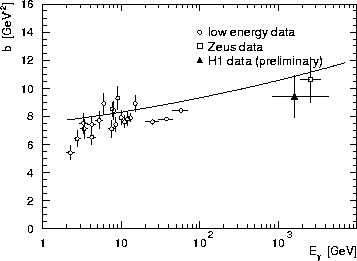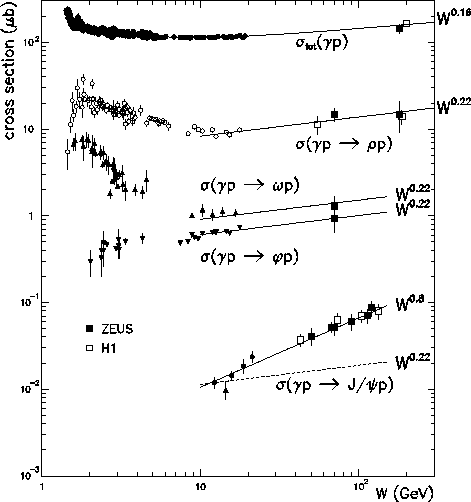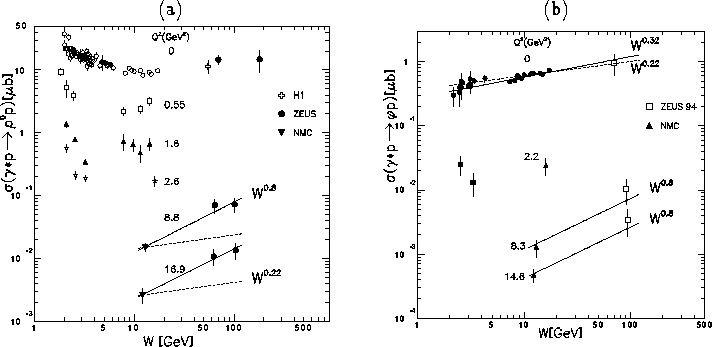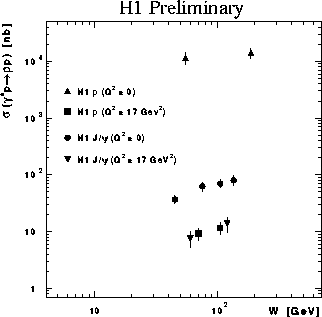The experimental signals are the exclusive production of the vector mesons in the following decay modes:
![]()
First results on ![]() and
higher vector mesons (
and
higher vector mesons ( ![]() and
and
![]() ) are in
the early analysis stages and first candidates for
) are in
the early analysis stages and first candidates for
![]() are also appearing in the data.
are also appearing in the data.
The clean topology of these events results in typical errors on the measured
quantities (t, M2, W2 and Q2), reconstructed in the tracking
chambers, of order 5%.
Containment within the tracking chambers corresponds to a W interval
in the range ![]() GeV. However, some analyses are restricted
to a reduced range of W where the tracking and trigger systematics
are well understood. Conversely, H1 have also used the
shifted vertex data to
extend the analysis of the
GeV. However, some analyses are restricted
to a reduced range of W where the tracking and trigger systematics
are well understood. Conversely, H1 have also used the
shifted vertex data to
extend the analysis of the ![]() cross section to higher
cross section to higher
![]() GeV.
At small t there are problems triggering and, to a lesser extent,
reconstructing the decay products of the vector meson. In particular,
the photoproduction of
GeV.
At small t there are problems triggering and, to a lesser extent,
reconstructing the decay products of the vector meson. In particular,
the photoproduction of ![]() mesons is limited
to
mesons is limited
to ![]() GeV2, since the produced kaons are just above threshold and
the available energy in the decay is limited.
In order to characterise the t-dependence, a fit to
the diffractive peak is performed.
In the most straightforward approach,
a single exponential fit to the t distribution,
GeV2, since the produced kaons are just above threshold and
the available energy in the decay is limited.
In order to characterise the t-dependence, a fit to
the diffractive peak is performed.
In the most straightforward approach,
a single exponential fit to the t distribution,
![]() for
for ![]() GeV2 is adopted.
GeV2 is adopted.
The contributions to the systematic uncertainties are similar in each
of the measurements.
For example, the uncertainties on acceptance of photoproduced
![]() 's are due to
uncertainties on trigger thresholds (
's are due to
uncertainties on trigger thresholds ( ![]() 9%),
variations of the input Monte Carlo distributions (
9%),
variations of the input Monte Carlo distributions ( ![]() 9%)
and track reconstruction uncertainties especially at low pT (
9%)
and track reconstruction uncertainties especially at low pT ( ![]() 6%).
In particular for the
6%).
In particular for the ![]() analysis,
where the mass distribution is skewed compared to a Breit-Wigner shape,
uncertainties arise due to the assumptions of the fit for the interference
between the resonant signal and the non-resonant background contributions
(
analysis,
where the mass distribution is skewed compared to a Breit-Wigner shape,
uncertainties arise due to the assumptions of the fit for the interference
between the resonant signal and the non-resonant background contributions
( ![]() 7%).
Other significant contributions to the uncertainty are contamination due to
e-gas interactions (
7%).
Other significant contributions to the uncertainty are contamination due to
e-gas interactions ( ![]() 2-5%) and from higher mass dissociated
photon states, such as elastic
2-5%) and from higher mass dissociated
photon states, such as elastic ![]() and
and ![]() decays (
decays ( ![]() 2-7%).
The uncertainty due to neglecting radiative corrections can also be
estimated to be
2-7%).
The uncertainty due to neglecting radiative corrections can also be
estimated to be ![]() 4-5% [7, 8].
4-5% [7, 8].
Finally, one of the key problems in obtaining accurate
measurements of the exclusive cross sections and the t slopes
is the uncertainty on the double dissociation component, where the
proton has also dissociated into a low mass nucleon system [14].
The forward calorimeters will see the dissociation
products of the proton if the invariant mass of the nucleon system, MN,
is above approximately 4 GeV.
A significant fraction of double dissociation events produce a limited mass
system which is therefore not detected.
Proton remnant taggers are now being used further down
the proton beamline to provide constraints on this fraction and, in
the H1 experiment, further constraints are provided by measuring
secondary interactions in the forward muon system.
Based on ![]() data one finds that the dissociated mass spectrum falls
as dN/dMN2 = 1/MNn
with n = 2.20
data one finds that the dissociated mass spectrum falls
as dN/dMN2 = 1/MNn
with n = 2.20 ![]() 0.03 at
0.03 at ![]() GeV from CDF
measurements [15].
However it should be noted that this measurement corresponds to a restricted
mass interval. The extrapolation to lower masses is subject to
uncertainties and the universality of this dissociation is open to experimental
question, given the different behaviour at the upper vertex.
Precisely how the proton dissociates and whether the proton
can be regarded as dissociating independently of the photon system is not
a priori known. Currently, this uncertainty is reflected in the cross sections
by allowing the value of n to vary from around 2 to 3, although this
choice is somewhat arbitrary.
The magnitude of the total double dissociation contribution is estimated to
be typically
GeV from CDF
measurements [15].
However it should be noted that this measurement corresponds to a restricted
mass interval. The extrapolation to lower masses is subject to
uncertainties and the universality of this dissociation is open to experimental
question, given the different behaviour at the upper vertex.
Precisely how the proton dissociates and whether the proton
can be regarded as dissociating independently of the photon system is not
a priori known. Currently, this uncertainty is reflected in the cross sections
by allowing the value of n to vary from around 2 to 3, although this
choice is somewhat arbitrary.
The magnitude of the total double dissociation contribution is estimated to
be typically ![]() prior to cuts on forward energy deposition, a
value which can be cross-checked in the data with an overall uncertainty
of
prior to cuts on forward energy deposition, a
value which can be cross-checked in the data with an overall uncertainty
of ![]() which is due to the considerations above.
Combining the above uncertainties, the overall systematic errors in the
various cross sections are typically
which is due to the considerations above.
Combining the above uncertainties, the overall systematic errors in the
various cross sections are typically ![]() .
.
Photoproduction processes have been extensively studied in
fixed-target experiments,
providing a large range in W over which to study the cross sections.
The key features are the weak dependence of the cross section on W,
an exponential dependence on t with a slope which shrinks with increasing W
and the retention of the helicity of the photon by the vector meson.
The t dependence of the ![]() photoproduction data is illustrated in
Figure 2 where the H1 and ZEUS data are
compared to a compilation of lower energy data [16].
The data are consistent with a shrinkage
of the t slope with increasing
photoproduction data is illustrated in
Figure 2 where the H1 and ZEUS data are
compared to a compilation of lower energy data [16].
The data are consistent with a shrinkage
of the t slope with increasing ![]() , where
, where
![]() is the photon energy in the proton rest frame,
as indicated by the curve for soft pomeron exchange [17].
is the photon energy in the proton rest frame,
as indicated by the curve for soft pomeron exchange [17].

Figure 2: Dependence of the exponential slope parameter b as a function
of ![]() for exclusive
for exclusive ![]() photoproduction compared to the
soft pomeron exchange prediction of Schuler and Sjöstrand.
photoproduction compared to the
soft pomeron exchange prediction of Schuler and Sjöstrand.
The measured t slopes are
![]() GeV-2 (H1) [7] and
GeV-2 (H1) [7] and
![]() GeV-2 (ZEUS) [8] for the
GeV-2 (ZEUS) [8] for the
![]() (where similar single-exponential fits have been
applied). These values can be compared to
(where similar single-exponential fits have been
applied). These values can be compared to
![]() GeV-2 (ZEUS) [10] for the
GeV-2 (ZEUS) [10] for the ![]() and
and
![]() GeV-2 (H1) [13]
for the
GeV-2 (H1) [13]
for the ![]() .
Physically, the slope of the t dependence in diffractive interactions
tells us about the effective
radius of that interaction, R:
if d
.
Physically, the slope of the t dependence in diffractive interactions
tells us about the effective
radius of that interaction, R:
if d ![]() , then
b
, then
b ![]() 1/4 R2. The range of measured b slopes varies from
around 4 GeV-2 (
1/4 R2. The range of measured b slopes varies from
around 4 GeV-2 ( ![]() fm) to 10 GeV-2 (
fm) to 10 GeV-2 ( ![]() fm).
Further, the interaction radius can be approximately related to the
radii of the interacting proton and vector meson,
fm).
Further, the interaction radius can be approximately related to the
radii of the interacting proton and vector meson,
![]() .
Given
.
Given ![]() fm,
then this variation in b slopes corresponds to a significant change in
the effective radius of the interacting vector meson from
fm,
then this variation in b slopes corresponds to a significant change in
the effective radius of the interacting vector meson from
![]() fm to
fm to ![]() fm.
fm.

Figure 3: W dependence of the exclusive vector meson and total
photoproduction cross sections compared to various power law dependences
discussed in the text.
Integrating over the measured t dependence,
the W dependence of the results on
exclusive vector meson photoproduction cross sections
are shown in Figure 3 [18]. From the experimental perspective,
there is generally good agreement on the measured cross sections.
The ![]() total cross section is also shown in Figure 3,
rising with increasing
energy as in hadron-hadron collisions and consistent with a value of
total cross section is also shown in Figure 3,
rising with increasing
energy as in hadron-hadron collisions and consistent with a value of
![]() i.e. the total cross section increases as W0.16.
i.e. the total cross section increases as W0.16.
Given the dominance of the pomeron trajectory at high W and
an approximately exponential behaviour of the |t| distribution with slope
![]() , whose mean
, whose mean ![]() value
is given by 1/b, the diffractive cross section
rise is moderated from
value
is given by 1/b, the diffractive cross section
rise is moderated from
![]()
to
![]()
Here ![]() characterises the effective energy dependence
after integration over t.
The observed shrinkage of the diffractive peak
therefore corresponds to a relative reduction
of the diffractive cross section with increasing energy.
Such a dependence describes the general increase of the
characterises the effective energy dependence
after integration over t.
The observed shrinkage of the diffractive peak
therefore corresponds to a relative reduction
of the diffractive cross section with increasing energy.
Such a dependence describes the general increase of the
![]() ,
, ![]() and
and ![]() vector meson cross sections with increasing W.
However, the rise of the
vector meson cross sections with increasing W.
However, the rise of the ![]() cross section is clearly not described
by such a W dependence, the increase being described by an
effective W0.8 dependence. Whilst these effective powers are for
illustrative purposes only, it is clear that in exclusive
cross section is clearly not described
by such a W dependence, the increase being described by an
effective W0.8 dependence. Whilst these effective powers are for
illustrative purposes only, it is clear that in exclusive ![]() production
a new phenomenon is occurring.
production
a new phenomenon is occurring.
Qualitatively, the W0.8 dependence, corresponding to
![]() ,
could be ascribed
to the rise of the gluon density observed in the scaling violations of
F2.
The
,
could be ascribed
to the rise of the gluon density observed in the scaling violations of
F2.
The ![]() mass scale, M2, is larger than the QCD scale
mass scale, M2, is larger than the QCD scale
![]() , and it is therefore possible to apply pQCD
techniques.
Quantitatively, the theoretical analysis predicts that
the rise of the cross section is proportional to the square of the gluon
density at small-x and allows discrimination among the latest
parametrisations
of the proton structure function [19].
We also know from measurements of the DIS
, and it is therefore possible to apply pQCD
techniques.
Quantitatively, the theoretical analysis predicts that
the rise of the cross section is proportional to the square of the gluon
density at small-x and allows discrimination among the latest
parametrisations
of the proton structure function [19].
We also know from measurements of the DIS ![]() total cross
section that application of formula (1) results in a value of
total cross
section that application of formula (1) results in a value of ![]() which increases with increasing Q2, with
which increases with increasing Q2, with ![]() 0.2 to 0.25
at
0.2 to 0.25
at ![]() GeV2 [18].
The fact that the corresponding relative rise of F2 with decreasing
x can be described by pQCD evolution [20]
points towards a calculable function
GeV2 [18].
The fact that the corresponding relative rise of F2 with decreasing
x can be described by pQCD evolution [20]
points towards a calculable function ![]() for
for ![]() GeV2.
GeV2.
One contribution to the DIS ![]() total cross section is
the electroproduction of low mass vector mesons.
Experimentally, the statistical errors typically dominate with
systematic uncertainties similar to the
photoproduction case. The trigger uncertainties are significantly
reduced, however, since the scattered electron is easily identified
and the radiative
corrections, which are more significant (
total cross section is
the electroproduction of low mass vector mesons.
Experimentally, the statistical errors typically dominate with
systematic uncertainties similar to the
photoproduction case. The trigger uncertainties are significantly
reduced, however, since the scattered electron is easily identified
and the radiative
corrections, which are more significant ( ![]() [21]),
can be corrected for.
The W dependence of the DIS
[21]),
can be corrected for.
The W dependence of the DIS ![]() and
and ![]() cross sections
for finite values of Q2 are shown in Figure 4,
compared to the corresponding photoproduction cross sections.
The W dependence for the
cross sections
for finite values of Q2 are shown in Figure 4,
compared to the corresponding photoproduction cross sections.
The W dependence for the ![]() and
and ![]() electroproduction
data are similar to those for
the
electroproduction
data are similar to those for
the ![]() photoproduction data, consistent
with an approximate W0.8 dependence also shown in Figure 4.
An important point to emphasise here is that the relative production of
photoproduction data, consistent
with an approximate W0.8 dependence also shown in Figure 4.
An important point to emphasise here is that the relative production of
![]() to
to ![]() mesons approaches the quark model prediction of 2/9 at large
W and large Q2, which would indicate the applicability
of pQCD to these cross sections.
The measurements
of the helicity angle of the vector meson decay provide a measurement of
mesons approaches the quark model prediction of 2/9 at large
W and large Q2, which would indicate the applicability
of pQCD to these cross sections.
The measurements
of the helicity angle of the vector meson decay provide a measurement of
![]() for the (virtual) photon, assuming s-channel helicity
conservation, i.e. that the vector meson preserves the helicity of the photon.
The photoproduction measurements for the
for the (virtual) photon, assuming s-channel helicity
conservation, i.e. that the vector meson preserves the helicity of the photon.
The photoproduction measurements for the ![]() are consistent with the
interaction of
dominantly transversely polarised photons
(
are consistent with the
interaction of
dominantly transversely polarised photons
( ![]() (ZEUS) [8]). However, adopting the same
analysis for virtual photons,
R=1.5+2.8-0.6 (ZEUS) [8],
inconsistent with the behaviour in photoproduction and
consistent with a predominantly longitudinal exchange.
This predominance is expected for an underlying
interaction of the virtual photon with the constituent quarks of the
(ZEUS) [8]). However, adopting the same
analysis for virtual photons,
R=1.5+2.8-0.6 (ZEUS) [8],
inconsistent with the behaviour in photoproduction and
consistent with a predominantly longitudinal exchange.
This predominance is expected for an underlying
interaction of the virtual photon with the constituent quarks of the ![]() .
Also, the measured
b slope approximately halves
from the photoproduction case to a value of
.
Also, the measured
b slope approximately halves
from the photoproduction case to a value of
![]() (ZEUS) [8], comparable to that
in the photoproduced
(ZEUS) [8], comparable to that
in the photoproduced ![]() case.
The
basic interaction is probing smaller distances, which allows a first comparison
of the observed cross section with the predictions of leading-log
pQCD (see [8]).
case.
The
basic interaction is probing smaller distances, which allows a first comparison
of the observed cross section with the predictions of leading-log
pQCD (see [8]).

Figure 4: W dependence of exclusive (a) ![]() and (b)
and (b) ![]() electroproduction cross sections for fixed values of Q2 compared
to various power law dependences discussed in the text.
electroproduction cross sections for fixed values of Q2 compared
to various power law dependences discussed in the text.
Finally, first results based on the observation of 42 ![]() events at
significant
events at
significant ![]() GeV2 have been reported by H1 [13].
The cross section has been evaluated in two W intervals in order
to obtain an indication of the W dependence, as shown in
Figure 5, where an estimated 50% contribution due to double dissociation has
been subtracted [22].
The electroproduction data are shown with statistical errors only
although the systematics are estimated to be smaller than these errors
(
GeV2 have been reported by H1 [13].
The cross section has been evaluated in two W intervals in order
to obtain an indication of the W dependence, as shown in
Figure 5, where an estimated 50% contribution due to double dissociation has
been subtracted [22].
The electroproduction data are shown with statistical errors only
although the systematics are estimated to be smaller than these errors
( ![]() ).
The electroproduction and photoproduction
).
The electroproduction and photoproduction ![]() data are consistent with
the W0.8 dependence (
data are consistent with
the W0.8 dependence ( ![]() ) noted previously.
The
) noted previously.
The ![]() electroproduction cross section is of the same order of
that of the
electroproduction cross section is of the same order of
that of the ![]() data, in marked contrast to the significantly lower
photoproduction cross section for the
data, in marked contrast to the significantly lower
photoproduction cross section for the ![]() , even at HERA energies,
also shown in Figure 5.
Further results in this area would allow tests of the underlying dynamics
for transverse and longitudinally polarised photons coupling to light
and heavy quarks in the pQCD calculations.
, even at HERA energies,
also shown in Figure 5.
Further results in this area would allow tests of the underlying dynamics
for transverse and longitudinally polarised photons coupling to light
and heavy quarks in the pQCD calculations.

Figure 5: H1 measurements of the W dependence of
electroproduction and photoproduction cross sections of exclusive vector
mesons.
In conclusion, there is an accumulating body of exclusive vector meson
production data, measured with a systematic precision of ![]() , which
exhibit two classes of W2 behaviour: a slow rise consistent with that
of previously measured diffractive data for low M2 photoproduction
data but a significant rise of these cross sections
when a finite Q2 and/or a significant M2 is measured.
, which
exhibit two classes of W2 behaviour: a slow rise consistent with that
of previously measured diffractive data for low M2 photoproduction
data but a significant rise of these cross sections
when a finite Q2 and/or a significant M2 is measured.